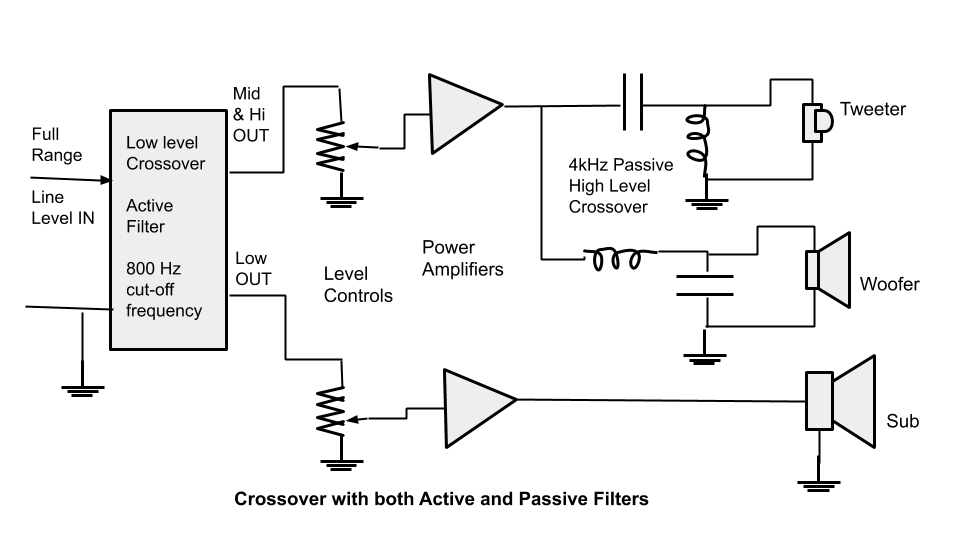Crossovers are not the most glamorous or talked about gear in live sound, but they are an integral part of the signal chain. Also known as frequency divider networks, these devices filter and route the signal based on frequency. Without a crossover, the same signal gets fed to each driver in the system. Imagine the tweeter, mids, and sub all playing the same song reading the same balance of frequencies. The poor tweeter’s exerting just as much energy into sound waves exponentially larger than itself as its favorite treble tones, therefore reducing the overall output or worse. And what about the sub, as graceful as a hippo, muddying the high end? A crossover, at its core, is a collection of filters based on the needs of the system. Depending on the scope of the system they can be a simple circuit, or be a highly customizable device. However, every crossover has to address a crossover point and the frequency responses of the components within the system.
Every crossover contains at least one filter. These filters determine the range of frequencies each speaker unit reproduces. A high-pass filter allows high frequencies to be sent to a tweeter, a low-pass filter allows low frequencies, and a band-pass filter allows a range of frequencies. The customization of the signal is the filter’s selectivity. When these filters intersect, they have a crossover point. In an ideal world these filters would be a brick wall, blocking any frequency beyond their cut-off point, the reality is that filters roll-off (a drop in decibels per distance from cut-off). Depending on the makeup of the filter (how many filter circuits, whether it is passive or active or digital), the slope of the roll-off can be steep or gradual. The order of the crossover refers to both the slope and the number of filter circuits required. Most sound reinforcement crossovers are 2nd-order (12dB/octave slope) or 4th-order (24dB/octave). Higher output systems rely on the steeper roll-off to protect high-frequency drivers from blowing out.
Knowing all of this about your crossover and about the optimal frequency ranges of the drivers or units in your system informs your choice of crossover point. If you choose cut-off frequencies too close to each other, the crossover frequency will get a gain boost by both speakers, too far and you won’t hear that frequency at all. If a driver is tasked with too wide of a frequency band, its power output will diminish and the signal might have other inaccuracies. Manufacturers include recommended crossover frequencies with the signal response of their speakers and drivers to inform optimal performance. When designing a speaker for studio use, where the system and location is consistent and stationary, this choice can be made permanent. In Live Sound, tuning is done with each individual load-in, as the acoustics of the room can change the performance of the system. Although not a rule by any means, these two situations describe the two basic types of crossovers: passive and active.
Passive crossovers (aka high-level) crossovers are downstream from the power amplifiers in the signal flow. They are often encountered as built-in circuitry in speaker enclosures, dividing frequencies between tweeters and woofers in full-range speakers. They are economical, however, the crossover’s quality is key to the performance of the system. Because of their location in the signal flow, they must have sufficient power handling capabilities, although too much focus on this can result in a bulky device. Within a passive crossover is a network of resistors, capacitors, and inductors, these are known as “passive” components in electronics. The more complicated the network, the steeper the roll-off, and the larger the components, the better power handling. Due to the nature of a passive crossover, they are generally less efficient and not adjustable when compared to active crossovers.
Where passive crossovers are high-level, active crossovers are low-level. They are implemented into the system at line level before the power amplifiers and are more efficient than passive crossovers. Variable level controls for each frequency band are often available for active crossovers to compensate for devices further along the signal chain. This is done with active components (op-amps and transistors) provide voltage gain, and resonant components (resistors, capacitors, and inductors) to select the frequencies. Many systems use a combination of both passive and active crossovers, and even have an option of bypassing the passive portion for more control capabilities. When used together the passive network is dedicated to the high-frequency horns and tweeters, and the active crossover covers the rest.
Other crossover styles available are digital or processor-controlled, and mechanical. Digital crossovers offer greater flexibility than active and greater capability for brick-wall roll-offs. Mechanical crossovers are more often found in speaker and driver designs in the form of domes, whizzer cones, and cabinet construction. While they function differently than active or passive, the basic concept of filtering frequencies is similar to the more conventional crossovers.
